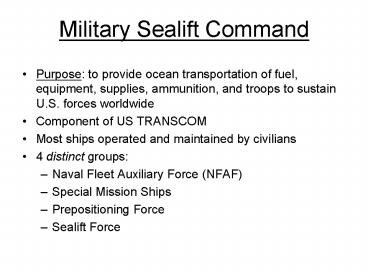Military Sealift Command PowerPoint PPT Presentation
1 / 18
Title: Military Sealift Command
1
Military Sealift Command
- Purpose to provide ocean transportation of fuel,
equipment, supplies, ammunition, and troops to
sustain U.S. forces worldwide - Component of US TRANSCOM
- Most ships operated and maintained by civilians
- 4 distinct groups
- Naval Fleet Auxiliary Force (NFAF)
- Special Mission Ships
- Prepositioning Force
- Sealift Force
2
History
- After WWII, 4 govt agencies controlled ocean
transportation and were consolidated under
Military Sea Transportation Service (MSTS) in
1949. - Renamed Military Sealift Command (MSC) in 1970
- 1972 Navy manned these ships with civilians.
This saved money, while allowing military
personnel to be better utilized on combatants. - OPERATION Desert Storm MSC moved over 95 of the
total ammo, cargo, and equipment used by U.S.
forces in the Middle east. - MSC still plays vital role in supporting military
services overseas and keeping Navy ships
refueled/replenished at sea.
3
Workforce
- Today, Military Sealift Command has more than
10,800 employees worldwide, approximately 80
percent of which serve at sea. - MSC is the largest employer of merchant mariners
in the United States. - Approximately 5,100 employees are federal civil
service - 660 are military personnel
- 4,600 are employed by MSC contractors.
4
Naval Fleet Auxiliary Force (NFAF)
- 34 civilian-manned vessels supporting the combat
elements of the Navy - Vessels are designed and manned to provide UNREPS
to Navy ships at sea - Fleet Tugs, Ammo Ships, Replenishment Oilers,
Hospital Ships, Stores Ships, Fast Combatant
Support Ships - CIVMARS - federal govt employees who are
civilian mariners on MSC ships. - Designated USNS
- Help with Navy missions of Power Projection, Sea
Control, and Forward Presence - Letter T precedes civilian-manned ships (i.e.
T-AOE 8)
5
MSC Ship Inventory
- Military Sealift Command currently daily operates
an average of 110 non-combatant, civilian-crewed
ships worldwide. In addition, the command has
access to other ships that are kept in reduced
operating status, ready to be activated if needed.
6
Ammunition Ships
- 7 ammo ships in operation
- T-AE is designator. C
- Can also carry dry cargo and fuel for CSGs
ESGs - Can resupply up to 3 ships at the same time. (Two
alongside, One via vertrep) - Can carry up to 2 helicopters
7
Fleet Tugs
- 5 tugs in operation with designator T-ATF
- Towing, diving support, salvage and other
services to the Navy - One tug assigned to each fleet commander at any
time
8
Oilers
- 13 oilers in operation with designator T-AO
- Carry jet fuel (JP-5) fuel for surface ships
(DFM) - Can refuel 2 ships simultaneously
- Carriers on the port side
9
Combat Stores Ships
- 6 ships in operation with designator T-AFS
- Provide dry cargo and fresh/frozen foods to
strike groups at sea - Like Ammo ships, they can deliver provisions to
multiple ships at the same time via CONREP
VERTREP
10
Fast Combatant Support Ships
- Most capable logistics ships in the world. Can go
up to 30 knots. Designator T-AOE - Deploy with CSGs
- Carry fuel, food, ammo, dry cargo. Can also
carry up to 2 helicopters. - Navy began transforming USS to USNS in 2001
11
Hospital Ships
- 2 ships in operation with designator T-AH
- 300 hospital beds and 12 operating rooms on each
12
Special Mission Ships
- 29 ships in operation around the world
- Duties include oceanographic hydrographic
surveying, cable-laying, missile range, ocean
surveillance, counter drug ops, rescue missions,
and Navy submarine testing support
13
Afloat Prepositioning Program
- Operates 35 ships at sea in 3 theatres of
operation - 15 USMC (maritime prepositioning),
- 13 USA (combat prepositioning),
- 7 logistics prepositioning (USAF, other
services ammunition equipment) - Form the backbone of the Navys strategic sealift
mission
14
Maritime Prepositioning Force(MPF)
- Support the USMC overseas.
- Hold tanks, food, fuel, parts, engine oil, ammo,
etc - 3 squadrons
- MPS Squadron One 5 ships located in Atlantic
Ocean or the Med - MPS Squadron Two 6 ships located in Diego
Garcia - MPS Squadron Three 4 ships located in
Guam/Saipan area - Each Squadron carries enough equipment/supplies
to sustain up to 17,000 USMC Air Ground Task
Force personnel for up to 30 days
15
Combat Prepositioning Force
- 15 ships that support the Army overseas
- 8 large roll on/roll off ships located in the
Persian Gulf - 4 contain equipment and 4 contain vehicles and
cargo
16
Logistics Prepositioning Force
- As of 2001, 7 ships were operating for the USMC
(2), USAF (3), USN (1) and Defense Logistics
Agency (DLA) (1) - Provide basic logistics to forward deployed units
for each branch of service
17
Sealift
- Logistical support on behalf of the DODs global
operations - 3 groups of ships 15 tankers support the NFAF, 8
surge ships support MSC, and 16 ships support the
DODs cargo transportation needs
18
Summary
- Overall, MSC is the largest and most capable
shipping organization in the world. - Its ability to support the US Navy at sea in 5
operating areas while supporting the USA, USAF,
and USMC allows MSC to stand alone in the
logistics world

